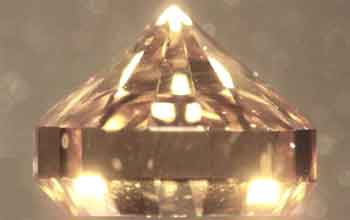|

Media Advisory 04-14
Third Annual Earth Day Distinguished Lecture

Large "Artificial" Diamonds Made from Gas Are Hardest Yet
April 14, 2004
Producing a material that is harder than natural diamond has been a goal of scientists for decades. Now a group headed by geophysicist Russell Hemley of the Carnegie Institution of Washington (D.C.), has produced gem-sized diamonds that are harder than any other crystals. The scientists made the diamonds at a rate 100 times faster than other methods used to date. The process opens up a new way of producing diamond crystals for electronics, cutting tools and other applications.
Hemley and colleagues developed a special high-growth-rate chemical vapor deposition (CVD) process to grow the diamond crystals. They then subjected the crystals to high-pressure, high-temperature treatment to further harden the material. The method has been used to "grow" diamonds up to 10 millimeters across and 4.5 millimeters thick. The crystals are at least 50 percent harder than conventional diamonds; the diamonds were so hard they broke the scientists' measuring equipment. The researchers were able to grow the gem-sized crystals in a day.
In celebration of Earth Day 2004, Hemley will speak at the National Science Foundation, which funds the team's research, about the CVD process and the resulting super-diamonds.
|
Who:
|
Russell Hemley, Lead Scientist, Single Crystal CVD Diamond Project, Carnegie Institution of Washington
|
|
What:
|
Third Annual Earth Day Distinguished Lecture--Large Diamonds Made from Gases Hardest Yet
|
|
When:
|
Thursday, April 22, 2004
10:00 a.m.
|
|
Where:
|
National Science Foundation
4201 Wilson Blvd., Room 110
Arlington, VA 22230
(Ballston Metro, enter at the corner of 9th and Stuart Streets)
|
-NSF-

Media Contacts
Cheryl L. Dybas, NSF (703) 292-7734 cdybas@nsf.gov

The National Science Foundation (NSF) is an independent federal agency that
supports fundamental research and education across all fields of science and
engineering, with an annual budget of $6.06 billion. NSF funds reach all 50
states through grants to over 1,900 universities and institutions. Each year,
NSF receives about 45,000 competitive requests for funding, and makes over
11,500 new funding awards. NSF also awards over $400 million in
professional and service contracts yearly.
 Get News Updates by Email Get News Updates by Email
Useful NSF Web Sites:
NSF Home Page: http://www.nsf.gov
NSF News: http://www.nsf.gov/news/
For the News Media: http://www.nsf.gov/news/newsroom.jsp
Science and Engineering Statistics: http://www.nsf.gov/statistics/
Awards Searches: http://www.nsf.gov/awardsearch/
| 

